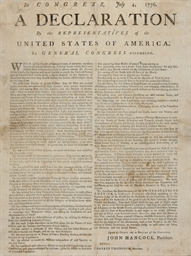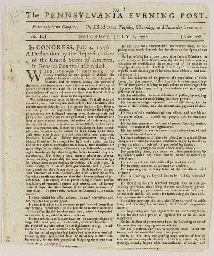DECLARATION OF INDEPENDENCE – In Congress, July 4, 1776. Declaration by the Representatives of the United States of America, In General Congress Assembled. When in the course of human events … solemnly Publish and Declare, that these United Colonies are of right ought to be, Free and Independent States … Signed by Order and in Behalf of the Congress, John Hancock President. Attest. Charles Thompson [sic] Secretary. [Exeter: Robert Luist Fowle, July, 1776.] A rare contemporary broadside printing of the Declaration of Independence: the Goodspeed-Sang-Streeter copy. The Declaration, Thomas Jefferson later wrote, was intended ''to be an expression of the American mind,'' reflecting ''the proper tone and spirit called for by the occasion'' (letter to Henry Lee, 8 May 1825). The Continental Congress, after authorizing the writing of the Declaration and approving the text submitted by Thomas Jefferson and his committee, took steps to ensure the rapid dissemination of the historic document. When the approved text was adopted on 4 July 1776, Congress directed that copies ''be sent to the several Assemblies, Conventions & Committees or Councils of Safety and that it be proclaimed in each of the United States.'' Philadelphia printer John Dunlap, working on the night of 4 July, set in type a bold broadside of the Declaration, and beginning on 5 & 6 July, John Hancock President of Congress dispatched copies to the state assemblies and to Generals George Washington and Artemas Ward. The quick dissemination of the historic text of the Declaration may be vividly traced in newspapers and broadside editions from its birthplace in Philadelphia throughout the thirteen self-proclaimed states, as rapidly as express riders and the post could carry it. Philadelphians saw this critical document published first on 6 July in the Pennsylvania Evening Post. Those in Baltimore were able to read the critical document as early as 9 July in Dunlap's Maryland Gazette; New Yorkers could read it between 10 and 15 July in three of that city's newspapers and three broadside printings. Mary Goddard’s Maryland Journal printed it in Baltimore on 10 July. The Maryland Gazette, in Annapolis, published it on the 11th. The next three weeks saw newspaper or broadside printings in New London, Connecticut; Providence, Rhode Island; Hartford, Norwich, Exeter, Salem, Worcester, New Haven, Portsmouth and Williamsburg. Of the fourteen contemporary broadside editions of the Declaration, including the present copy, five bear no imprints. Frederick Goff convincingly attributed it to Robert Luist Fowle, printer of the New Hampshire Gazette or Exeter Morning Chronicle. Most extant examples were found in southern New Hampshire and the text corresponds closely to the Declaration's text as printed in Fowle's Gazette (16 July 1776). See Goff, "A Contemporary Broadside Printing of the Declaration of Independence," Quarterly Journal of Current Acquisitions (Washington: Library of Congress, November 1947), Vol. 5, No. 1, pp. 12-16. Walsh 15, Bristol B4408; the second state of this printing with the final three lines reset, including correction to "Hancock", which was misprinted as “Hacock” in the first state. We are aware the existence of a total of ten extant copies of this broadside, only two of which are known in the first state. We are grateful to Seth Kaller for sharing his extensive research on this edition. Provenance: Goodspeed, 1964 – Thomas W. Streeter (his sale, Sotheby Parke Bernet, 19 April 1967), lot 784 – Phillip Sang (his sale, Sotheby's, New York, 26 April 1978, lot 83, miscatalogued as Walsh 14) – descendants of the purchaser. A note on the text: Like Solomon Southwick in Newport, E. Russell in Salem and John Gill in Boston, Fowle's printing altered Dunlap's adjectival "divine" to the noun "Divine." And like John Gill, Fowle set the text in two columns—a format common to the printing of biblical texts. While the motivation for these choices remains a matter of conjecture
DECLARATION OF INDEPENDENCE – In Congress, July 4, 1776. Declaration by the Representatives of the United States of America, In General Congress Assembled. When in the course of human events … solemnly Publish and Declare, that these United Colonies are of right ought to be, Free and Independent States … Signed by Order and in Behalf of the Congress, John Hancock President. Attest. Charles Thompson [sic] Secretary. [Exeter: Robert Luist Fowle, July, 1776.] A rare contemporary broadside printing of the Declaration of Independence: the Goodspeed-Sang-Streeter copy. The Declaration, Thomas Jefferson later wrote, was intended ''to be an expression of the American mind,'' reflecting ''the proper tone and spirit called for by the occasion'' (letter to Henry Lee, 8 May 1825). The Continental Congress, after authorizing the writing of the Declaration and approving the text submitted by Thomas Jefferson and his committee, took steps to ensure the rapid dissemination of the historic document. When the approved text was adopted on 4 July 1776, Congress directed that copies ''be sent to the several Assemblies, Conventions & Committees or Councils of Safety and that it be proclaimed in each of the United States.'' Philadelphia printer John Dunlap, working on the night of 4 July, set in type a bold broadside of the Declaration, and beginning on 5 & 6 July, John Hancock President of Congress dispatched copies to the state assemblies and to Generals George Washington and Artemas Ward. The quick dissemination of the historic text of the Declaration may be vividly traced in newspapers and broadside editions from its birthplace in Philadelphia throughout the thirteen self-proclaimed states, as rapidly as express riders and the post could carry it. Philadelphians saw this critical document published first on 6 July in the Pennsylvania Evening Post. Those in Baltimore were able to read the critical document as early as 9 July in Dunlap's Maryland Gazette; New Yorkers could read it between 10 and 15 July in three of that city's newspapers and three broadside printings. Mary Goddard’s Maryland Journal printed it in Baltimore on 10 July. The Maryland Gazette, in Annapolis, published it on the 11th. The next three weeks saw newspaper or broadside printings in New London, Connecticut; Providence, Rhode Island; Hartford, Norwich, Exeter, Salem, Worcester, New Haven, Portsmouth and Williamsburg. Of the fourteen contemporary broadside editions of the Declaration, including the present copy, five bear no imprints. Frederick Goff convincingly attributed it to Robert Luist Fowle, printer of the New Hampshire Gazette or Exeter Morning Chronicle. Most extant examples were found in southern New Hampshire and the text corresponds closely to the Declaration's text as printed in Fowle's Gazette (16 July 1776). See Goff, "A Contemporary Broadside Printing of the Declaration of Independence," Quarterly Journal of Current Acquisitions (Washington: Library of Congress, November 1947), Vol. 5, No. 1, pp. 12-16. Walsh 15, Bristol B4408; the second state of this printing with the final three lines reset, including correction to "Hancock", which was misprinted as “Hacock” in the first state. We are aware the existence of a total of ten extant copies of this broadside, only two of which are known in the first state. We are grateful to Seth Kaller for sharing his extensive research on this edition. Provenance: Goodspeed, 1964 – Thomas W. Streeter (his sale, Sotheby Parke Bernet, 19 April 1967), lot 784 – Phillip Sang (his sale, Sotheby's, New York, 26 April 1978, lot 83, miscatalogued as Walsh 14) – descendants of the purchaser. A note on the text: Like Solomon Southwick in Newport, E. Russell in Salem and John Gill in Boston, Fowle's printing altered Dunlap's adjectival "divine" to the noun "Divine." And like John Gill, Fowle set the text in two columns—a format common to the printing of biblical texts. While the motivation for these choices remains a matter of conjecture
.jpg)
.jpg)













Try LotSearch and its premium features for 7 days - without any costs!
Be notified automatically about new items in upcoming auctions.
Create an alert